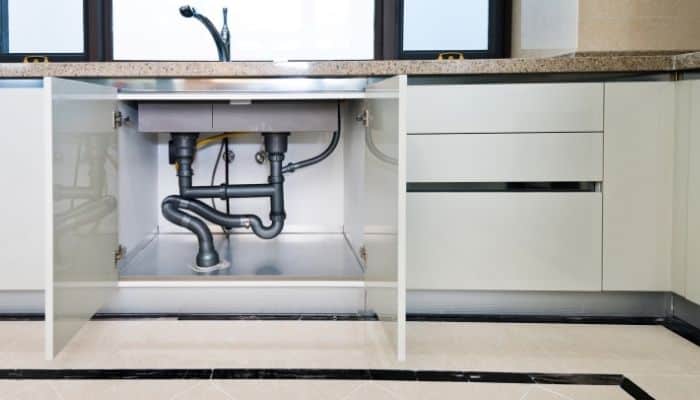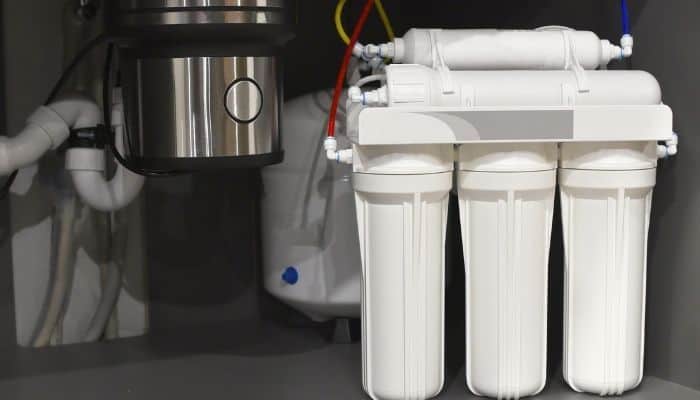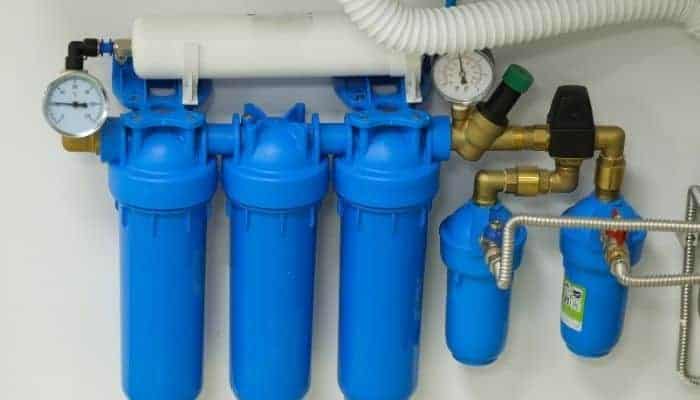In Brief: Common Problems With Under Sink Water Filters & How To Troubleshoot
Under sink water filters are frequently used in many households. There can be a lot of issues that crop up with the use of such a filtration system. These issues can be discoloration of water, drop in water pressure, unwanted odors, water leakage, etc. The following article describes some of these problems that you may encounter in day-to-day life and how to effectively troubleshoot these issues.
Under Sink water filters are compact in design because they have to be fitted in tight spaces.
They are on-demand models that filter the water as soon as the faucet is turned on and do not have a storage tank to store the filtered water. There is also no wastage of water.
All of the purified water is passed onto the sink faucet.
The under sink water filter operates under a constant stream of water that maintains an absolute pressure so that as soon as the faucet is opened, the filtered water flows through smoothly.
The installation is a relatively simple setup that many homeowners can get running by themselves. However, it is common to expect some issues if you are not familiar with the product.
Below, we look at some of the problems one could face with under sink water filters and how to troubleshoot them.
The most common problems with under sink water filters are covered below. You, the reader, can solve most of these problems, and consequently, you save a lot of dollars that would be spent on professional help.
Below, we briefly discuss some of these problems. We also guide you on how to deal with them in a DIY setup.
1. Filter Clogging
Clogging of filters is the most common issue with under sink water filters.
Over time, as filters keep filtering out the impurities from the water, their effectiveness reduces. Some of the common indicators of a clogged filter are listed below.
- Water is not adequately filtered (noticeable change in taste or odor)
- Noticeably reduced water pressure
- Discoloration of the filter
When you start noticing that the performance of the filter is compromised, you may undertake the following steps to rectify the situation.
How to troubleshoot –
The reasons for filter clogging could be one of the following.
1. Non-regular maintenance
Filters require regular upkeep to ensure that their composition remains uncompromised.
Efficient upkeep means that you should take out the filter cartridge at regular intervals and clean it. You can devise a maintenance schedule and carry out the cleaning process according to it.
Cleaning the filter should be done without using any soap or abrasive material that can damage the filter. You should use a soft cleaning pad that will get the job done nicely.
It is recommended to carry out the cleaning process every few weeks for optimal performance. However, one may plan this according to their requirements.
A few considerations for this would be the frequency of usage, quality of the incoming water, and life of the filter.
If this is the underlying problem with the filter, you will notice that the performance will be improved and restored to the original levels after carrying out the cleaning process. If the problem persists, move onto the alternate solution.
2. End of the filter life
Another reason for the poor performance of the filter could be that it is near the end of its life.
All the manufacturers clearly state the duration for which the filter can work effectively. The filter life is described in terms of months or gallons of water that they can filter.
If the filter is nearly at the end of its useful life, you should make sure to have a replacement filter at hand.
Check out how to replace an under sink water filter cartridge in a quick video at
If the problem persists, check out the next solution.
3. Hard water supply
Despite regular maintenance, it may be the case that the filter is getting clogged frequently, and the quality of filtered water degrades rapidly. A common reason for this is the quality of the incoming water.
If the water supply to the household delivers extremely hard water, it can cause filter degradation. Most filters are not designed to handle hard water beyond a particular level. Hard water also causes a rapid build-up of scale in the system, which negatively affects the performance of the under sink water filter.
You should check the hardness of the incoming water, and if it is too high for the filter to handle, a water softener should be installed in the house so that the water passes through the softener before it can reach the filter.
If nothing works, the manufacturer can be contacted using the information provided in the instruction manual.
Most companies also have a robust customer helpline that allows one to contact the professionals at any time with any problem.
Most of the commonly faced issues are also covered under warranty, and one can quickly seek a replacement or repair for any problem, if applicable.
Under Sink Water Filter Fitting Issues
Although the installation of most under sink water filters is a reasonably straightforward process, given its simple design, you could get confused with some small technicalities.
For this, we have provided a simple step-by-step checklist to ensure that all the essential steps are carried out.
How to troubleshoot –
- After unpacking all the equipment from the kit, you should disconnect the cold water supply.
- The kit includes a brass tee that should be attached to the supply line. You have to connect the threaded end of the tee to the supply line.
- The next step is to attach the inlet tubing to the brass tee with the help of a compression nut.
- Then attach the outlet tubing to the faucet. Make use of the tightening wrenches provided in the kit to avoid damage to the equipment.
- Next, mount the under sink filtration unit in a suitable space such that there are at least 12 inches from the bottom.
- The batteries that are provided with the filtration unit should be inserted into the designated compartment. There will be an LED light that will flash a certain number of times to indicate this has been done correctly. (This step may vary from one model to the next)
- The next step is to connect the sumps to the filtration systems.
- The inlet and outlet lines are then attached to the filtration unit.
- Turn on the cold water supply line to check if the system is working correctly.
3. Water Running to the Drain
This problem occurs when there is an issue with the incoming water pressure and if there is a malfunction in the automatic shutoff valve that is fitted in most water filtration systems.
All the under sink water systems require a certain minimum level of water pressure to operate.
This water pressure has to be maintained throughout the filtration process so that the water can be filtered optimally without wastage.
If the pressure falls below a certain threshold, there will be a marked decline in the supply of purified water.
A malfunction in the valve can be harder to detect and is the last step that needs to be checked for this problem.
How to troubleshoot –
1. In case of Inadequate water pressure
This issue can be sorted by installing a water pump in the plumbing system of the household. Some filtration systems include data regarding the pumps that they are compatible with.
Installing these pumps will ensure that the water circulation within the system maintains at a constant level.
If the problem persists, move on to the next step.
2. In case of Malfunction of the automatic shutoff valve
This problem is slightly harder to detect. To check if this is the case, make sure that the tank is full. The next step is to remove the drain line from the saddle.
After this, you have to close off the cold water supply to the unit. If the water is still flowing in the pipe, it indicates that there is a problem with the valve.
The valve will have to be replaced to rectify this problem. Professional help can be sought for this, as it might be slightly tricky for DIY.
The valve replacement should rectify the water drainage problem. If it persists, you can seek professional help for the same.
4. Leaking Problem and Water Damage to the House
The under sink water filters are housed inside casings. These filters are also rated to operate under a certain level of water pressure.
If subjected to a higher pressure than recommended, the housing may crack, or there may be leakage from the otherwise watertight sealing.
This can cause a lot of damage to the house if it goes unnoticed. Not only will the water corrode the cabinet, but there will also be unnecessary wastage of water and possible flooding.
How to troubleshoot –
If there are reported leakages, the first thing to do is to check the source of leakage.
- If the connections of the pipes are loose, these connections should be fastened tightly with the help of a wrench. Care should be taken not to secure these too tightly as that can also cause cracking.
- If the waterproof sealing on the filter has worn off, you have to replace the same at the earliest. This measure is to prevent any aggravation in the leakage.
- If the leakage is due to a crack in the water filter housing, you should check whether it is possible to repair the same. You should also check if the repair or possible replacement is covered by the manufacturer’s warranty. If this is the case, the company can be contacted to do the needful.
If the cracked housing is not covered under warranty, one should check if replacement parts are available. If not, the last step is to invest in a new under sink water filter.
5. Tank Problems in an Under Sink Water Filter
Before passing through the water filter cartridge, the water supplied to the household passes through the tank of the water filter.
This tank has to be in top shape to facilitate the smooth movement of water through the system.
Over time, however, due to inadequate water quality or infrequent maintenance activities, the tank may get clogged with impurities and hamper the flow of water.
How to troubleshoot –
If the supply of water to the household delivers hard water, you should install a water softener in the plumbing system before the water passes through the water filter.
This will help in increasing the life of the water filter.
Regular maintenance activities, including cleaning of the tank, can go a long way in extending the useful life of an under sink water filter.
We mention below a step-by-step procedure to clean an under sink water filter.
- Switch off the cold water supply under your sink.
- Drain the lines from the water filter tap by switching it on and letting the remnant water run until it stops running.
- You should have a bucket handy to catch any excess water that might be found in the filter housing.
- Remove the housing from under the sink (if mounted to the wall) and place it in the empty bucket.
- Use the wrench to loosen the sumps and remove them by unscrewing them.
- Once detached, empty the housing off any water that is still inside and remove the cartridges.
- Clean the grime build-up inside the filter housing using some hot water.
- You can also add some lubrication around the O-rings, but it should strictly be food-grade lubrication.
- After cleaning the housing thoroughly, put the cartridges back inside the filter housing.
- Screw the filter housing back using the wrench.
- Turn on the water supply to restore normal function.
6. Low Water Pressure
One of the most common issues after the installation of an under sink water filter is a reported decline in the flow of water.
This low water pressure could be due to a clogged filter or insufficient water pressure in the incoming supply.
How to troubleshoot –
If the reduction in the flow of water is gradual i.e., if the filter initially delivered sufficient water flow and gradually showed a decline in the stream, this is due to the build-up of grime and scale over the weeks or months of use.
This issue can be solved easily by cleaning the water filter.
If the problem is persistent from the start, the issue may be related to low incoming water pressure.
In this case, you should install a water pump in the pipeline to regulate the pressure of water at a constant rate.
The regulation will help the water flow through the filter at a steady pace, which is neither too fast nor too slow, ensuring that the filtration happens appropriately.
Most water filters have a recommended pressure range for optimum output. Be sure to check this rating before buying a water pump.
If nothing works
There can be a variety of problems with an under sink water filtration system, and this is by no means an exhaustive list.
Therefore, you should invest a fair amount of time in diagnosing the exact problem with the filter before carrying out the troubleshooting steps.
You can also always use the company’s helpline to understand the exact problem and make use of the warranty to get any necessary repairs done within the warranty period.
Sometimes the cost of repairs can be too much, and it may make more sense to invest in a new filtration system, especially if the current system has been in place for a long time.
You should make prudent choices regarding the product to minimize the cost expended in this activity.
Summary
There can be many other problems with an under sink water filter that could be causing the unsatisfactory performance of the unit.
These problems usually have a minor underlying cause, and if you can figure out this cause, rectifying the problem is simply a matter of following the necessary steps to get the system up and running.



